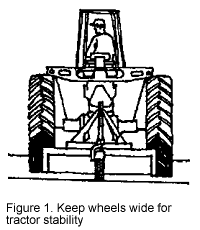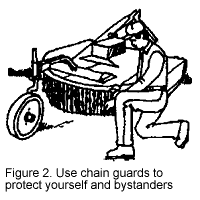An accident with a rotary mower can cost you your life! A rotary agricultural mower can also injure innocent bystanders, so it is also important that they be alert and aware of safety rules. Using proper equipment correctly, keeping equipment in good repair and following safety practices are the best ways to prevent accidents.

Before operating your mower, study your operator's manual carefully to familiarize yourself with its maintenance procedures.
Begin your pre-operational check by making sure the power take-off is disengaged and the engine is shut off. Look for loose nuts and bolts.
Blade sharpness is a key to efficient, safe mowing. Inspect the blades often, and replace them when they become too dull for additional sharpening.
Remember that hazards increase when you are having problems with the equipment.
 Rotary mowers are equipped with runners and safety guards.
To avoid excessive wear on the runners, keep the mower just
high enough so that it does not ride on the runner shoes.
Rotary mowers are equipped with runners and safety guards.
To avoid excessive wear on the runners, keep the mower just
high enough so that it does not ride on the runner shoes.
Guards Chain or belt guards (Fig. 2) reduce the possibility of objects being thrown from under the mower. Be sure these guards are maintained and kept in place.
Power take-off shafts should also be protected by shields or guards. Keep them in place on the machine.
If
you are under 16, a federal
child-labor law affects you. Unless you are working for your
parent or guardian on a farm owned or operated by that person,
you are not permitted to operate a tractor over 20 PTO horsepower
and certain other farm machines, although some of these jobs
can be started at age 14 if you have special training. Young
people under 14 may be employed to do any job that is not
particularly hazardous if they have the written consent of
their parent or guardian. There is one exception: children
under 12 are not permitted to work on farms that used 500 or
more man-days of labor during any quarter of the preceding
calendar year. Check with your county Extension office for
further details.
Publication #: AEX-592
This document is a series of the Agricultural Engineering Department, Ohio State University Extension, Ohio State University, Columbus, Ohio 43210. Publication date: December 1991.
Thomas L. Bean, Safety Leader, Ohio State University Extension, Ohio State University, Columbus, Ohio 43210. Reviewed by Dr. Joe Gliem and Dr. Randall Wood.
Disclaimer and Reproduction Information: Information in NASD does not represent NIOSH policy. Information included in NASD appears by permission of the author and/or copyright holder. More